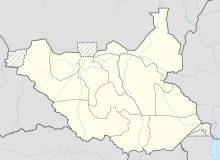Kodok
Coordinates: 9 ° 53 ' N , 32 ° 7' E
Kodok , formerly Faschoda , is a city in the state of Upper Nile in South Sudan .
The city is located at 390 m above sea level, around 650 km south of Khartoum on the western bank of the White Nile , on the settlement area of the Shilluk and Dinka .
history
During the conquest of Sudan by Egypt in 1820 a small fort was built here, which was cleared after the beginning of the Mahdi uprising in 1883 . In 1898 the place was in the area of interest claimed by Great Britain and France alike and was the scene of the Faschoda crisis . The dispute was in 1899 in Sudan contract settled. After the Anglo-French Entente cordiale in 1904 , Faschoda was renamed Kodok to erase the memory of this conflict.
The evangelical Church Mission Society (CMS) was awarded areas from Kodok to the south by the British colonial administration for proselytizing in 1898 after it had been denied the Khartoum site . The Catholic Verona Fathers received the area west of the Nile, the Presbyterian Church (USA) was allowed to evangelize from Kodok to the east as far as the Ethiopian border. From 1900 the missionaries were there in small numbers and without any problems, from the 1920s the CMS complained to the colonial government about an expansion of the Catholics beyond their territory. In January 1933 the Catholic Mission sui juris was set up in Kodok , which in 1938 became an apostolic prefecture (since 1974 diocese of Malakal ), from the 1930s Kodok was also a center for the Presbyterians .
In 1955 the population was around 9,100. During the First Sudanese Civil War , Kodok was the scene of a massacre by the military in 1964 , in the reign of Muhammad Ahmad Mahdschub . Similar massacres took place in other cities in South Sudan in 1964 and 1965 .
The famine in the 1990s years tried in Malakal stationed aid organizations under the umbrella of Operation Lifeline Sudan to fight. In 2004 and 2005 , at the end of the Second Civil War , the UNHCR was active in Kodok and looked after returning civil war refugees . The security situation was considered very critical in 2004, and attacks by Sudanese soldiers on the civilian population were reported.
The Shilluk around Kodok mainly operate subsistence agriculture and grow millet as a source of food , cattle breeding is of less economic importance than with the Dinka . In the area between Kodok and Malakal, south of the Nile, there are repeated fights between the two ethnic groups over land rights and water distribution. They are old unresolved conflicts.
Blackthorn acacias and Seyal acacias grow in this area . In the mid-1990s, the marketing of gum arabic , which is extracted from the Seyal acacia and sold to Arab traders from the north, began.
See also
- Faschoda crisis , 1898
Individual evidence
- ^ MW Daly: Empire on the Nile. The Anglo-Egyptian Sudan 1895-1934. Cambridge University Press 2003, p. 251
- ↑ Manyang Mayom: Hundreds flee clashes in Malakal. Sudan Tribune, January 13, 2009

